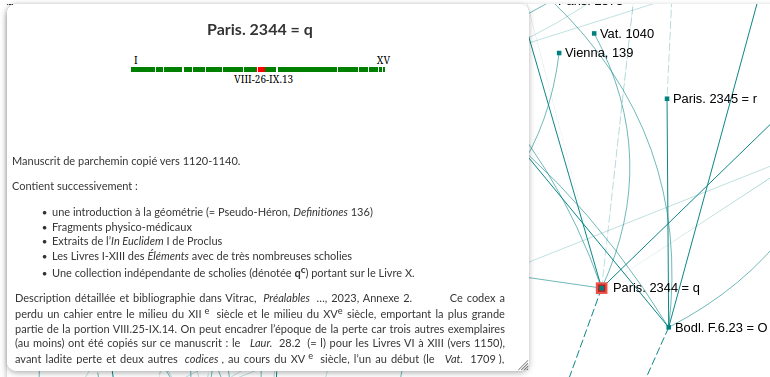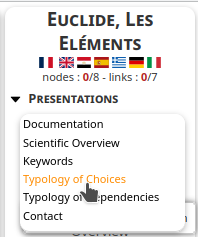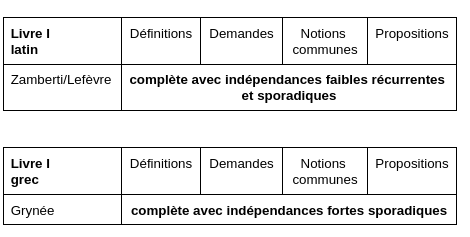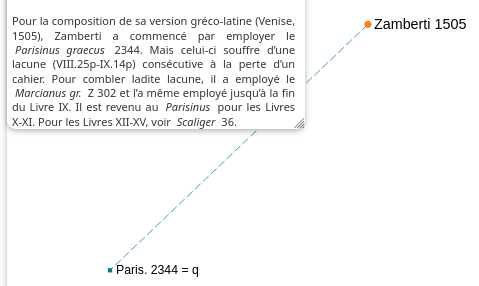
Notices
Notices pertain to the nodes, the source of the links, rarely to their target. References and notices on the links allow distinguishing specific clarifications and information related to them, thus differentiating them from those related to the nodes.
Some references to manuscripts and printed editions contained in a notice are clickable. Clicking on them allows finding the node and thus easily referring to it.
Node notices
Notices for manuscripts and printed editions include a horizontal bar indicating the preserved or edited Books.

Preserved and lost parts of Laur. 28.8

Translated books preserved by Boethius

Books translated by Commandino
Manuscript notices
The nodes of all Greek manuscripts are accompanied by a notice including their brief description, indicating their lacunae, sometimes elements of their history, and indications of their potential models. Similar (and concise) information is given for manuscripts of versions in other ancient languages, such as:
in Arabic for those of the so-called Ishâq-Thâbit version;
in Latin for the copies of the Arabo-Latin translations by Adelard of Bath and Hermann of Carinthia…
and for the Cambridge manuscript of the Hebrew version known as Rabbi Jacob.
These notices do not replace specialized publications related to the manuscript in question and indicated in the graph.

Notice on Paris. 2344 = q
Printed edition notices
The early editions of the main printed editions and some others are accompanied by a notice providing indications of their relationship to their potential sources.
Structural correlations
The editions under study include, under the title ‘Structural Correlations,’ a table summarizing the percentage of shared values on structural characteristics related to definitions, Common Demands and Notions, and proposition statements. Most of these characteristics have been derived from manuscript analysis.

Table of structural correlations by Commandino 1572
Their number may vary, as the absence of one characteristic makes another irrelevant, but there are more than 120 characteristics for the 13 Books, half of which are found in the first 6 Books. These characteristics, individually relevant, provide indications of potential sources but are not sufficient, despite their relatively large number, for their determination. To do this, the selected editions are not based solely on quantitative criteria but on other analyses (see below), and some are provided for comparison, either to show proximity or structural divergence.
Typology by choice
The editions under study also include, under the title ‘Typologie par choix’ (Typology by choice), their characterization in a typology based on the distinction of certain choices made by these editions. This typology offers a simple but relevant way to distinguish editions based on their relationship to their sources. It pertains to the identified sources, but it neither enables nor justifies their identification.
Its presentation is accessible from the graph:

Typology by dependencies
Some of the editions under study also include, under the title ‘Typologie par dépendances’ (Typology by dependencies), their characterization in another typology based on analyses that cover over 2,000 criteria distributed across all 13 Books, with nearly 1,400 concentrated in Book I, spread across 680 types, and using the corpus analysis program. These descriptions take into account both dependencies and independencies among all editions of the considered corpus at different extensions and levels of textual units. A one-sentence description, distinguishing definitions, Common Demands, Notions, propositions, and demonstrations, provides a sufficient characterization of the respective differences and proximities of these editions.

Characterization of Fine’s edition on Book I in the typology by dependencies
The complete reports of these analyses will be published under the name MÉδÉE as they are completed, among the ‘Études sur’ dedicated to the edition.
When they exist, it is generally these analyses that have allowed for the identification of the sources indicated on the graph. Once a source has been identified, it is easy to verify, to a greater or lesser extent, that the considered edition depends on it in the indicated way. Direct comparison of the two texts remains the best way to understand their complex relationship. However, determining that a similar dependence does not exist with any other edition of the corpus cannot be established without a program.
Notices on links
Similar to nodes, a notice can be associated with a link to document it. The notice generally serves to record a specific element establishing the existence of the link, to justify the choice of its target, especially for Greek manuscripts, and to specify its support.

Notice on a link